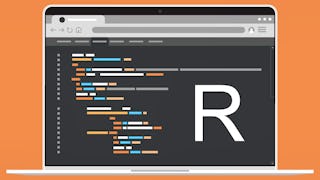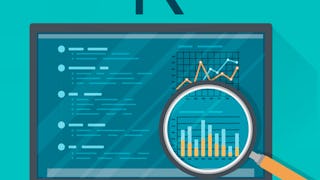Mis à jour en mai 2025.Ce cours intègre désormais Coursera Coach ! Une façon plus intelligente d'apprendre avec des conversations interactives en temps réel qui vous aident à tester vos connaissances, à remettre en question vos hypothèses et à approfondir votre compréhension au fur et à mesure que vous progressez dans le cours.Ce cours approfondi commence par vous guider à travers les bases de la programmation R, de la configuration de l'environnement avec R et RStudio à la compréhension de son interface utilisateur. Au fur et à mesure que vous avancerez dans les premières sections, vous plongerez dans les concepts de programmation fondamentaux tels que les types de données, les fonctions et les opérations vectorielles, ce qui vous permettra de construire une base solide en R. Vous apprendrez également à manipuler des structures complexes telles que les matrices et les cadres de données, ce qui facilitera l'organisation et la manipulation efficace des données. Au fur et à mesure que le cours progresse, vous explorerez des capacités plus avancées de R, telles que la création et la modification de cadres de données, en utilisant le populaire package dplyr, et en travaillant avec des opérateurs relationnels, logiques et des boucles. Les leçons sur la Manipulation et la Visualisation des données offrent une expérience pratique du nettoyage et de la présentation des données, avec des outils essentiels comme ggplot2 pour créer des graphiques et des diagrammes intéressants. Ces compétences vous aideront à analyser les données et à prendre des décisions basées sur les données de manière plus efficace. Enfin, le cours se penche sur les statistiques avec l'analyse exploratoire des données, les tests d'hypothèse et la modélisation de la régression linéaire. En maîtrisant ces techniques, vous serez en mesure d'analyser des données du monde réel, d'en tirer des enseignements significatifs et de faire des prédictions. Que vous soyez un scientifique des données en herbe ou un statisticien cherchant à perfectionner ses compétences, ce cours fournit tout ce dont vous avez besoin pour réussir dans le domaine de la science des données en utilisant R. Ce cours est conçu pour les scientifiques des données en herbe, les statisticiens et les professionnels cherchant à maîtriser R pour l'analyse des données. Des connaissances de base en programmation sont souhaitables, mais pas obligatoires.

Profitez d'une croissance illimitée avec un an de Coursera Plus pour 199 $ (régulièrement 399 $). Économisez maintenant.

Programmation R pour les statistiques et la science des données

Instructeur : Packt - Course Instructors
Inclus avec
(10 avis)
Expérience recommandée
Ce que vous apprendrez
Différencier les structures de données (vecteurs, matrices, cadres de données)
Effectuer des tests d'hypothèse et interpréter les résultats statistiques
Évaluer l'adéquation des modèles de régression linéaire
Visualisation des données en cours d'utilisation ggplot2 pour une présentation pertinente
Compétences que vous acquerrez
- Catégorie : Transformation de données
- Catégorie : Science des données
- Catégorie : Probabilités et statistiques
- Catégorie : Programmation Statistique
- Catégorie : Statistiques descriptives
- Catégorie : Visualisation de Données
- Catégorie : structures de données
- Catégorie : La programmation en R
- Catégorie : Modélisation statistique
- Catégorie : Ggplot2
- Catégorie : Manipulation de données
- Catégorie : Analyse des Données
- Catégorie : Analyse statistique
- Catégorie : Analyse exploratoire des données (AED)
- Catégorie : Tidyverse (Package R)
- Catégorie : Analyse de régression
- Catégorie : Principes de programmation
Détails à connaître

Ajouter à votre profil LinkedIn
6 devoirs
Découvrez comment les employés des entreprises prestigieuses maîtrisent des compétences recherchées

Il y a 11 modules dans ce cours
Dans ce module, nous allons explorer les étapes fondamentales nécessaires pour commencer à utiliser R et RStudio pour l'analyse statistique et la science des données. Vous apprendrez à installer et à configurer les logiciels nécessaires, à vous familiariser avec l'interface de RStudio et à modifier son apparence pour l'adapter à vos préférences. En outre, vous comprendrez comment installer et gérer les packages essentiels pour étendre les fonctionnalités de R.
Inclus
6 vidéos1 lecture
Dans ce module, nous allons nous plonger dans les éléments fondamentaux qui constituent la programmation R. Vous apprendrez à créer et à travailler avec différents types de données tels que les entiers, les doubles, les caractères et les logiques. Nous explorerons le fonctionnement des fonctions, comment construire vos propres fonctions et comment les règles de coercion affectent les types de données. En outre, nous comparerons l'utilisation de l'éditeur de script à celle de la console pour un codage efficace.
Inclus
8 vidéos
Dans ce module, nous nous concentrerons sur les vecteurs, l'une des structures de données fondamentales de R. Vous comprendrez comment les vecteurs sont créés et manipulés, vous apprendrez le recyclage des vecteurs et découvrirez comment nommer les vecteurs pour plus de clarté. Nous aborderons également les techniques de découpage et d'indexation des vecteurs, et nous explorerons comment ajuster les dimensions des objets en fonction de vos besoins en matière de données. En outre, vous serez initié aux fonctions d'aide de R afin de résoudre les problèmes et d'approfondir vos connaissances.
Inclus
7 vidéos1 devoir
Dans ce module, nous nous pencherons sur les matrices, une autre structure de données essentielle dans R. Vous apprendrez à créer des matrices à la fois de manière traditionnelle et à l'aide de lignes de commande simples pour plus d'efficacité. Nous explorerons le recyclage des matrices, la manière d'indexer des éléments spécifiques et les techniques de découpage des matrices pour récupérer des sous-ensembles de données. En outre, vous effectuerez des opérations arithmétiques sur les matrices et explorerez des sujets connexes tels que la gestion des données catégoriques, la création de facteurs et le travail avec des listes dans R pour une gestion plus complexe des données.
Inclus
10 vidéos
Dans ce module, nous aborderons les concepts de programmation de base qui vous permettent d'écrire un code R efficace et flexible. Vous apprendrez à utiliser les opérateurs relationnels et logiques, à travailler avec des vecteurs dans le cadre d'opérations logiques et à contrôler le flux de votre programme à l'aide des instructions if, else et else if. Nous explorerons également les boucles - telles que for, while et repeat - et nous plongerons plus profondément dans la construction de fonctions en tenant compte de la portée et des meilleures pratiques. Ces concepts sont essentiels pour automatiser des tâches et structurer des programmes R plus complexes.
Inclus
10 vidéos
Dans ce module, nous allons explorer les cadres de données, une structure de données essentielle pour traiter les données tabulaires dans R. Vous apprendrez à créer des cadres de données, à utiliser le package Tidyverse pour rationaliser la manipulation des données et à importer/exporter des ensembles de données de manière efficace. Nous aborderons des techniques clés telles que l'indexation, le découpage et l'extension des cadres de données, ainsi que des stratégies de gestion des données manquantes. Ces compétences vous permettront de travailler efficacement avec des ensembles de données du monde réel dans R.
Inclus
10 vidéos1 devoir
Dans ce module, nous nous concentrerons sur les techniques essentielles de manipulation des données qui vous permettront de travailler efficacement avec de grands ensembles de données dans R. Vous explorerez le package (R) dplyr pour la transformation des données, y compris le filtrage, la mutation et le résumé des données. Nous verrons également comment échantillonner les données et utiliser l'opérateur pipe pour enchaîner les commandes de manière transparente. Enfin, vous apprendrez à mettre de l'ordre dans les ensembles de données à l'aide de fonctions telles que gather, separate, unite et spread, afin de préparer les données pour l'analyse dans un format structuré et propre.
Inclus
7 vidéos
Dans ce module, nous explorerons le puissant package ggplot2 pour créer différents types de visualisations de données dans R. Vous apprendrez à construire des histogrammes, des diagrammes en barres, des graphiques en boîte et des diagrammes de dispersion afin d'interpréter visuellement vos données. Nous reviendrons également sur le rôle des variables et sur la manière dont elles peuvent être représentées dans des formats graphiques. Ces visualisations vous aideront à découvrir des tendances, des schémas et des aperçus qui sont cruciaux dans les statistiques et la science des données.
Inclus
8 vidéos
Dans ce module, nous aborderons les concepts clés de l'Analyse exploratoire des données (AED) qui permettent de résumer et de comprendre la structure des données. Vous apprendrez les différences entre les populations et les échantillons, calculerez les mesures de tendance centrale et explorerez la distribution des données par le biais de l'asymétrie. Nous nous pencherons également sur les mesures de variabilité telles que la variance, l'Écart-type et le Coefficient de variation, et nous terminerons par une introduction à la covariance et à la corrélation, qui permettent d'identifier les relations entre les variables.
Inclus
5 vidéos1 devoir
Dans ce module, nous explorerons les concepts fondamentaux des Tests d'hypothèse dans l'analyse statistique. Vous découvrirez les différentes distributions, l'importance de l'erreur standard et la manière de calculer et d'interpréter les intervalles de confiance. Nous verrons également comment effectuer des tests d'hypothèse, le rôle des Valeurs P et la différence entre les tests lorsque la variance de la population est connue ou inconnue. En outre, vous comparerez deux moyennes dans des scénarios d'échantillons dépendants et indépendants, tout en comprenant les erreurs potentielles qui peuvent survenir lors des tests d'hypothèse.
Inclus
9 vidéos
Dans ce module, nous allons nous plonger dans les principes fondamentaux de l'analyse de régression linéaire. Vous découvrirez le modèle de régression linéaire, sa comparaison avec la corrélation et sa représentation géométrique. Nous vous guiderons dans l'exécution de votre première régression dans R, dans l'interprétation du tableau de régression et dans la compréhension de la décomposition de la variabilité à l'aide de SST, SSR et SSE. En outre, vous explorerez la signification du R au carré et la manière dont il reflète le pouvoir explicatif du modèle. Ces concepts sont essentiels pour comprendre les relations dans les données.
Inclus
7 vidéos3 devoirs
Instructeur

Offert par
En savoir plus sur Analyse des Données
 Statut : Essai gratuit
Statut : Essai gratuit Statut : Essai gratuit
Statut : Essai gratuitJohns Hopkins University
 Statut : Essai gratuit
Statut : Essai gratuit Statut : Essai gratuit
Statut : Essai gratuitJohns Hopkins University
Pour quelles raisons les étudiants sur Coursera nous choisissent-ils pour leur carrière ?




Avis des étudiants
10 avis
- 5 stars
60 %
- 4 stars
30 %
- 3 stars
0 %
- 2 stars
10 %
- 1 star
0 %
Affichage de 3 sur 10
Révisé le 19 juil. 2025
its very god course and and amazing enjoyable and understandable recommended to all of you,.
Révisé le 19 mai 2025
The lessons are superbly arranged that makes them easy to understand
Révisé le 20 juil. 2025
Thank you for such a comprehensive, practical, and super-enjoyable course. Good luck!
Foire Aux Questions
Oui, vous pouvez visionner la première vidéo et le syllabus avant de vous inscrire. Vous devez acheter le cours pour accéder au contenu qui n'est pas inclus dans l'aperçu.
Si vous décidez de vous inscrire au cours avant la date de début de la session, vous aurez accès à toutes les vidéos et à toutes les lectures du cours. Vous pourrez soumettre vos travaux dès le début de la session.
Une fois que vous vous serez inscrit et que votre session aura commencé, vous aurez accès à toutes les vidéos et autres ressources, y compris les lectures et le forum de discussion du cours. Vous pourrez consulter et soumettre des évaluations pratiques, et effectuer les devoirs notés requis pour obtenir une note et un certificat de cours.
Plus de questions
Aide financière disponible,





